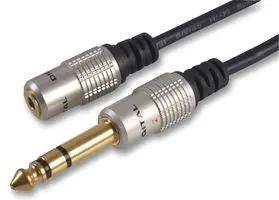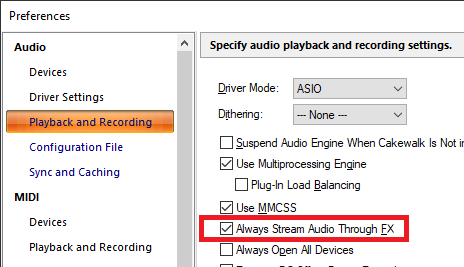-
Posts
6,101 -
Joined
-
Last visited
-
Days Won
26
Everything posted by msmcleod
-
I had this problem recently - turned out to be the 3.5mm to 1/4" headphone adapter I was using. I replaced it with a short cable instead:
-

Minimizing latency using software instruments.
msmcleod replied to Starise's topic in Instruments & Effects
This is not the case. VST's / VSTi's are in-process DLL's, so they run in the same process space as the host (i.e. your DAW). As such, they have the ability to adversely affect any of the threads the DAW is using if they're not written properly. Running it in JBridge effectively hides the issue - in other words, it's messing with JBridge's threads instead. -
-
This is no longer an issue.
-
This can happen if you've got a large amount of plugins, or several plugins with a large amount of parameters (e.g. TH3 / THU / Scheps Omni Channel ). This has been addressed for the next release.
-
-
From 2020.11 onwards, BandLab assistant isn't required for updates. It's only required for uploading/downloading BandLab projects (and of course the loop content)... which will likely change too in the future.
-

bug report Issue with magic tool when comping take lanes?
msmcleod replied to Cristiano Sadun's topic in Feedback Loop
http://www.cakewalk.com/Documentation?product=Cakewalk&language=3&help=Tools.04.html -

Minimizing latency using software instruments.
msmcleod replied to Starise's topic in Instruments & Effects
My mixes aren't particularly heavy, but I was getting clicks/pops even using a single instance of any of the UJAM Virtual Guitarist range without JBridge. I'm not using 32 bit versions - JBridge also supports 64 bit to 64 bit. Using JBridge just forces it to run in its own separate 64 bit process outside of CbB, which seems to cure it. The UJAM products are the only ones that I have to do this with. I'm also using a Scarlett, so this could be a common factor. The only other products I have similar issues with in CbB is any of the Antares VST3 plugins. For those, I just run the VST2 versions. Many of the iZotope plugins (esp Ozone) also give me grief, but I just avoid them completely unless I'm running them standalone. In saying that, Nectar seems to be fine. -

Minimizing latency using software instruments.
msmcleod replied to Starise's topic in Instruments & Effects
I've had issues with latency (or crackles/pops when the buffer size is anything but massive) with the UJAM Virtual Guitarist synths. I solved it by enabling JBridge for those synths. I can now run them with a buffer size of 64 (32 at a push). -
This is totally expected. Both RX7 and Adaptive Limiter are look-ahead plugins, which add significant latency. Every time a plugin is added, the highest latency is applied to the whole project. It needs to do this, so everything happens at the correct time. All DAWs work this way. There're a few ways around this: 1. Use the FX button on the control bar to bypass all effects. 2. Temporarily bypass the effects that are adding latency 3. Click the PDC button on the control bar to disable plugin delay compensation (this will mean things are recorded at the wrong time - but you can move your clips afterwards). 4. Temporarily Freeze the tracks with the high latency plugins on
-
It's probably tied to your workspace - try re-saving your workspace.
-
This has a bunch of grooves built in you can drag/drop to your tracks, and is also a great sounding drum VSTi: BandLab Assistant has a bunch of loops you can use too.
-
For a few years my dad used the Korg PSS-50 for his backing, which I believe used the same synth engine as the Poly 800. I remember being totally blown away with the sounds on that thing. It had a jack input with this really cool stereo widener effect, which I occasionally used with my 4 track as an effect. All the DWGS synths ( Poly 800 , DW 6000, DW 8000, DSS-1 etc ) where very underrated IMO, but I guess Yamaha (DX series) & Roland (Juno / Jupiter series & D series) were huge competition. IIRC the PSS-60 which replaced it used an 4-op FM chip like the DS8, which to my ears was no where near as nice.
-
It was similar to the Sound Brush - it used 3.5" DD disks, except that it used its own proprietary disk format, and didn't use standard MIDI files (unlike the Sound Brush which read/recorded SMF on DOS disks). It did the standard recording/playing MIDI, but it also had sysex dump request formats for a bunch of different devices which was great for backing up synth / guitar processor patches. The disk format was also specifically designed to support random access using MIDI song position. I used it in an ADAT / BRC equipped studio back in the early 90's to sync up the BRC with all my keyboard parts. You could fast forward to any part within a song, and it'd pick up in exactly the right spot, with all controllers/notes chased in less than a second. For live use, it was mainly for changing patches across my whole rig (it'd support a single program change to send everything out - sysex and all)... but we did have one 20 minute song that had a bunch of extra sound effects and doubled up parts throughout that ran as a sequence. But yeah, I moved over to minidisc in the end too for backing tracks.
-
On the rare occasions I use USB mics, I tend to go for WDM as a driver mode. The latency is lousy, but it is pretty reliable, and plays nicely with multiple audio devices. Just remember to change the recording timing master to whatever you're recording with. Once I've done my recording though, it's straight back to ASIO.
-
I had similar experiences with my Amiga 500. It was solid indoors, but out of the 3 times I used it live, it let me down badly twice. This however, was rock solid:
-

How Use Kensington Trackball to Scroll Through Tracks
msmcleod replied to Alan Rabinoff's question in Q&A
Hold CTRL down while you're scrolling the wheel (SHIFT + CTRL will scroll by a bigger amount) -
The interleave has absolutely nothing to do with it. It's the VST's audio output channel that matters.
-
Ahh - interesting... this is the audio driver for the HDMI output. This has been known to cause issues for some people. Try disabling it.
-
Before I replied, I tried it out with TTS-1 ( just to make sure it actually worked ! 🙂 ) The thing is, is even if the synth dialog could do the stereo/mono mix/match thing, there's a whole lot of extra setup you're gonna have to do manually within your plugin in any case. For example, to get 6 x mono tracks and 1 x stereo track in TTS 1: I inserted 7 mono tracks of TTS-1, split the last track, assigned it to TTS-1 stereo output 4, and remade into an instrument track. But in TTS-1 itself, I had to go into the setup, assign parts 1 & 2 to output 1, 3 & 4 to output 2, 5 & 6 to output 3, and 7 to output 4. I then had to pan parts 1,3 & 5 hard left, and parts 2,4 & 6 hard right. With Omnisphere, there was no way to make the outputs mono - you'd have to alter the patches themselves (or maybe CC 10 might work to pan them in the MIDI track itself). But my point is, adding that flexibility isn't gonna save you much work.
-

Windows update thread -20H2 current ( also, impact on CW )
msmcleod replied to aidan o driscoll's topic in The Coffee House
I've not had any issues with 20H2 so far... although getting it installed was a bit of a chore on my main studio pc. I must have tried 20-30 times to upgrade to both 2020 & 20H2, and had a BSOD every time on the 2nd boot. In the end, the issue turned out to be Korg's USB driver (comes with the nanoKONTROL series). This is only used by the Korg Editor software and isn't needed for normal use. I've got a Windows 7 boot partition with this installed, so its not a big deal. I also suspect NI's WinCDEmu driver was causing issues too (this is only required for Windows 7), so I uninstalled that too. It was plain sailing from then on. -

Volume taper not happening on two MIDI tracks
msmcleod replied to Michael McBroom's topic in Cakewalk by BandLab
My experience of CC7 vs CC11 on GM type instruments is... CC7 (Volume) - affects the volume of the channel only for any new notes played after the CC7 is sent. Notes that are already playing are unaffected. CC11 (Expression) - affects the volume of the channel while notes are still playing, but only up to the volume set by CC7. In other words, if CC7 is set to 80, then a CC11 of 127 will mean a max volume of 80. For hardware instruments, CC7 is fairly widely supported, but not in all modes - e.g. multi-type modes might accept it, but single or combi (performance) modes may not. CC7 isn't as widely supported on soft synths, as people generally control the audio output volume instead. CC11 isn't as widely supported on either hardware or software synths, and it isn't always mapped to controlling volume (even though the MIDI spec says it should be). If you're using soft synths though, consider using audio volume instead. -
It's not a missing feature, it's designed that way to make things quick for the most common usage. Adding more options to the Insert Soft Synth dialog would just make it more complicated than it already is. For 99% of use cases you'd want all the outputs to be all stereo or all mono (e.g. all stereo outputs for a synth VSTi or all mono outputs for a drum VSTi). It's pretty rare to mix & match. However there's nothing to stop you inserting them as all mono, splitting the last one, changing it to stereo, then recombining it.








